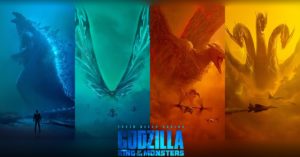Godzilla: King of the Monsters
Posted on May 30, 2019 at 5:32 pm
B| Lowest Recommended Age: | Middle School |
| MPAA Rating: | Rated PG-13 for sequences of monster action violence and destruction, and for some language |
| Profanity: | Strong language |
| Alcohol/ Drugs: | None |
| Violence/ Scariness: | Extended fantasy/sci-fi action, peril, and violence, massive destruction |
| Diversity Issues: | None |
| Date Released to Theaters: | May 31, 2019 |
| Date Released to DVD: | August 26, 2019 |

All of that is on display in “Godzilla: King of the Monsters,” an Avengers-style roundup of the classic kaiju (“strange beast”) monsters from post-WWII movies about enormous creatures who cause massive destruction as white-coated scientists make frantic calculations, the military deploys its most powerful weapons, skyscrapers are knocked down, politicians debate, and ordinary people run and scream. And so we have our title character, Godzilla, who has been a, well, monster hit at the box office, with the longest continuously running movie franchise, from 1954 to the present day, 35 films so far. Then there are the flying reptile Rodan, the gigantic insect-like Mothra, and the three-headed, dragon-like King Ghidorah.
And then there are the people. It would be a stretch to call them “characters” because they mostly exist to represent different sides in the movie’s key divide, metaphor for metaphor for a range of geopolitical issues ranging from refugees and immigration to environmental destruction to the role of public and private entities in national security and that oldest of themes, hubris, as reflected by the age of atomic weapons.
These issues are literally brought home in the way that a formerly married couple, Emma (Vera Farmiga) and Mark (Kyle Chandler) Russell, and their daughter Madison (“Stranger Things'” Millie Bobbie Brown). They were so traumatized by the death of their son in the last monster attack that they split up. Mark is now off in the wilderness studying wolves. Emma is still studying kaiju and working on a special thingamagig that can be used to control the monsters and prevent further destruction.
Only Madison knows about how Emma plans to use it. And when the monsters who had been dormant re-appear Emma brings Madison along in what appears to be a very poorly timed take your daughter to work day. As Emma’s colleagues are mowed down by an “eco-terrorist” (Charles Dance) Emma and Madison are captured.
Meanwhile, there is a debate in the outside world about how to deal with monsters. Should we kill them all? Should we acknowledge that they are the next stage of evolution and live with them? As one character says, when asked if they could just be our skyscraper-sized pets, “No, we would be theirs.” And the question of who really are the monsters is raised with just enough heft to add some interest without ever getting in the way of the reason for the movie, which is big things fighting with other big things.
I know, I know, you want me to get to the good stuff. And you can relax; I just spent more time on exposition than the film does. Co-writer/director Michael Dougherty knows why we’re here and boy, does he deliver, with the help of outstanding special effects and design crew. It is possible, I suppose, that you may have a chance to catch your breath at some point, in which case you might consider what the people behind that first Godzilla movie 65 years ago, with production values that might have seemed a bit crude even then, might think if they saw these never-less-than-spectacular kaiju, never less than majestic, every battle powerfully staged.
Even if they had worked on the characters and dialogue with as much imagination as they did with the creatures, it would just be a distraction. The international cast gives it what they can, but the only use for lines like “It’s an existential challenge to our world!” and “The earth unleashed a fever to fight the infection,” “You are messing with forces beyond your comprehension!” plus references to “playing God” and saving the world is to stay out of the way of the action. Happy summer — the popcorn pleasures have arrived.
Parents should know that this is a monster movie with extended sci-fi/fantasy peril, action, violence, mayhem, and destruction. Characters use strong language and there are issues of betrayal and family tensions.
Family discussion: What is the significance of the comment about the difference between the way Eastern and Western cultures see the stories about dragons? How would humans find a way to co-exist with monsters? Which humans behave like monsters?
If you like this, try: the kaiju movies, “Rampage,” and “Pacific Rim” and its sequel
